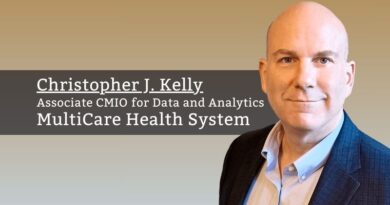The Role of Clinical Decision Support System in Achieving Patient Care and Enhancing Patient Safety
By Chani A Cordero, CIO, Brooke Army Medical Center
A gifted few have a memory of an elephant, smoothly juggling large amounts of information, but many of us rely on reminders. Similar to healthcare, it is impossible to remember every aspect of patient care. Medicine is quite complex, and memory alone cannot keep up with changing best practices, standards of care, and medical technology growth while simultaneously taking care of multiple patients.
The relentless pursuit of safety in aviation and the chase for patient safety and quality in healthcare are often studied and compared. One of the widely touted safety successes in aviation is using checklists. In the insightful book The Checklist Manifesto, we discover the transformative power of a simple checklist. Translated to current healthcare, clinical decision support systems (CDSS) have become the dynamic checklist of modern medicine. When embedded in the electronic health record (EHR) workflow, it will ensure standards of care that will standardize diagnostics and treatment plans.
Understanding CDSSs
CDSSs provide recommendations, alerts, or other methods designed to assist clinicians with making decisions with patient care, ideally at the point of care. However, what does that entail during patient care? It depends on the type of CDSS deployed. Primarily, there are two types: knowledge-based and non-knowledge-based CDSS. Knowledge-based CDSS leverages a comprehensive knowledge base comprising medical data and rules to provide informed recommendations and alerts to clinicians. Non-knowledge-based CDSS deploy machine learning (ML) algorithms and artificial intelligence (AI) to analyze vast data volumes, identifying patterns and trends that may not be immediately discernible.
Additionally, CDSSs are characterized as active or passive, meaning a passive system requires the user to do something to receive advice, like opening a dialogue box. In contrast, an active system automatically provides prompts based on information received. CDSS are potent tools that manifest in different forms, such as alerts, clinical diagnostics, drug contraindications, or order sets. We have seen evidence of effectiveness in medication safety with consistent CDSS usage. My organization incorporated drug-to-drug alerts that warn of possible allergy contraindications and suggest alternatives. Although pharmacists also review drug interactions, a CDSS provides an initial check that saves pharmacist a 45% reduction in time spent on verifying. The next step is to incorporate a decision support system that can adhere to clinical practice guidelines (CPGs).
While the adoption of CDSS in healthcare settings is growing, there are still substantial challenges to overcome. As we advance, the focus should be on addressing these barriers to further increase the adoption and optimization of these systems.
Clinical Practice Guidelines
Clinical practice guidelines are a consortium of recommendations to aid with diagnosing and treating a concern or condition. “The principal benefit of guidelines is to improve the quality of care received by promoting interventions of proven benefit and discouraging ineffective or potentially harmful interventions.” Additionally, CPGs can assist with diagnosis variance and treatment plans by establishing standards, including physician biases, which adversely affect patient care. “Bias in clinical practice, in particular in relation to race and gender, is a persistent cause of healthcare disparities.”
With the advancement of technology, the EHR can incorporate continuous CPGs. Unlike traditional provider methods of solely learning new techniques via continuing education credits or conference attendance, CPGs are updated as new facts and acceptances are established in real-time, which allows for the utmost patient care. “Clinical practice guidelines are the most important document for incorporating scientific evidence into healthcare decision-making recommendations.” When the CDSS is active within the workflow, it can reduce the biases for treatment.
Addressing Misconceptions About CDSS
Oftentimes, physicians’ reluctance to use CDSS is because of the notion that their expertise is discounted. However, CDSS is a tool that complements a clinician’s knowledge and experience while mitigating implicit bias. Additionally, it provides clinicians with additional information and resources, assisting them in making better-informed decisions. The ultimate decision will always be with the physician.
There’s a concern that clinicians might become overly reliant on CDSS, leading them to overlook their clinical judgment or become less skilled over time. CDSS is an aid, not a substitute, for thorough clinical assessment and sound clinical judgment. It’s there to support and enhance decision-making, not to take it over. Lastly, CDSS is not infallible. Various interest organizations have their “own perspective, goals, and intended uses.” Therefore, CPGs incorporated in a CDSS must be transparent, undergo a rigorous review process, and remain independent from payers. Additionally, it’s crucial for clinicians to critically evaluate the recommendations provided by CDSS, considering the entire clinical context and their knowledge.
Need for Widespread Adoption
Paying homage to the movie Field of Dreams alludes to the idea that “If you build it, he will come.” This is not the case for CDSS. Adoption by users remains low even though the evidence shows an increase in patient safety and quality. Suggestions or alerts are ignored for “reasons attributed to end-users’ negative attitudes, evasion or skepticism regarding the system.” Other barriers include a lack of integration within the EHR and trust in the system due to data quality issues. Due to common misconceptions, healthcare culture and resistance to change remain a significant barrier. While the adoption of CDSS in healthcare settings is growing, there are still substantial challenges to overcome. As we advance, the focus should be on addressing these barriers to further increase the adoption and optimization of these systems.
In conclusion, CDSSs are not merely technological advancements but are dynamic checklists poised to reform modern healthcare from its very core. Integral to EHR workflows, CDSS ensures that standards of care are met and consistently exceeded, standardizing diagnostics and treatment plans across the board. The result is an enhanced safety profile with tangible evidence in medication error reductions and a streamlined approach to healthcare delivery. I urge healthcare professionals, policymakers, EHR vendors, and experts to advocate for integrating and optimizing CDSS in healthcare. Our collective effort will ensure that these systems are not only adopted but also to ensure high-quality patient care. The future implications are clear: CPGs, intertwined with CDSS and embedded into clinical workflows, are set to become critical tools in directing evidence-based medicine into actionable healthcare decisions.



